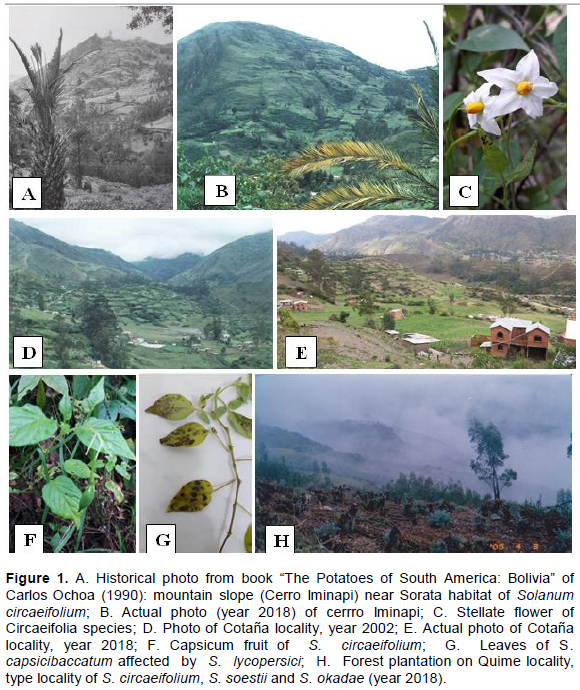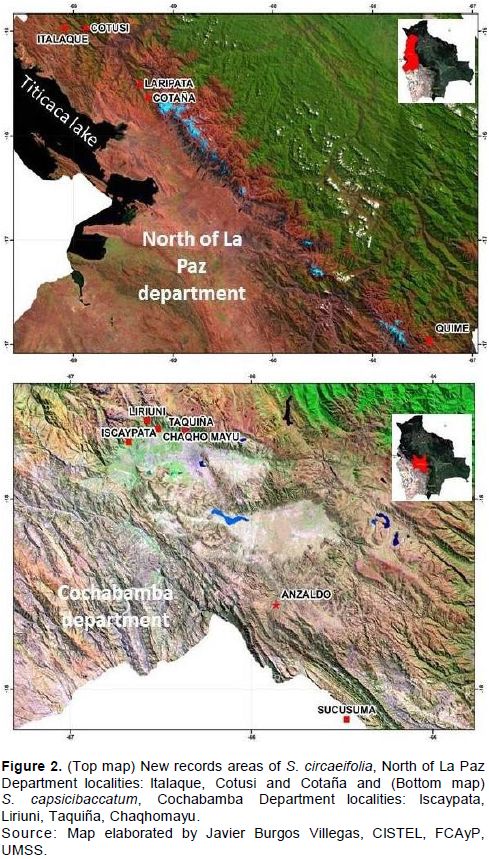The Circaeifolia series species are only from Bolivia. They are species that have particular morphological characteristics different from any other within the Petota section. The taxa of the series Circaeifolia, Solanum circaeifolim, Solanum capsicibaccatum and Solanum soestii (recently grouped as Solanum stipuloideum Rusby) have been distinguished by morphological characteristics and molecular analysis, however, they are not completely elucidated. Until 1994, some taxa, S. circaeifolium and S. soestii, had been considered "rare" because of their restricted geographic distribution. However, with recent data a new situation can be inferred for these Circaeifolia species. S. soestii, may be considered "rare" because it is confined to its type of locality or have restricted geographic distribution; conversely, S. circaeifolium and S. capsicibaccatum have a greater known distribution until 1994. Besides, several factors, such as anthropogenic activities (forest plantation, urbanization and agriculture expansion) and others related to climate change, like drought and forest fires, are threatening their extinction.
Crop wild relatives have a long history of use in potato breeding, particularly for pest and disease resistance (Castañeda-Álvarez et al., 2015). The members of series Circaeifolia (Solanum section Petota) (2n) are solely endemic to Bolivia (Ochoa, 1990), and can be found growing wild in the Yungas region of the Department of La Paz, the Choro-Ayopaya localities of the highlands and Caine River areas in the Cochabamba Department, and up to Valle Grande in the Department of Santa Cruz (Hawkes and Hjerting, 1989; Ochoa, 1990). The series have three-member species: Solanum circaeifolium Bitt. (Hawkes, 1994), Solanum capsicibaccatum Cárdenas and Solanum soestii Hawkes and Hjerting (Hawkes and Hjerting, 1989), although Ochoa (1990) proposed that the infraspecific category S. circaeifolium var. capsicibaccatum (Cárd.) Ochoa should also be included. Amplified fragment length polymorphism (AFLP) analysis has confirmed the three accepted species to be distinct (Spooner and Salas, 2006), although all have a whitish, stellate flower (Figure 1C) and elliptical or lanceolate fruits (Figure 1F) that distinguish them morphologically from the other species of Solanum section Petota (Hawkes and Hjerting, 1989; Ochoa, 1990; Spooner and Salas, 2006). Recently, these species of Circaeifolia series were regrouped in the taxa Solanum stipuloideum Rusby (Spooner and Knapp, 2013; Spooner et al., 2014). Hawkes (1994) indicated that S. circaeifolium and S. soestii, are among the eleven wild species "rare" potatoes of Bolivia (Table 1). However, subsequent prospecting studies have shown that some of the species in the Circaeifolia series have greater distribution (Figure 2) and others may still be considered "rare", but some anthropogenic activities are threatening their survival. For the current review, we consider each species separately taking into account the morphological characteristics described by Hawkes and Hjerting (1989) and Ochoa (1990).This paper records their presently known distributions and some factors related with anthropogenic activities and probable genetic erosion.

S. CIRCAEIFOLIUM
S. circaeifolium was collected in 1855-1861 (although Cárdenas (1973) indicates a date of 1864) by Gilbert Mandon in the Cerro Iminapi locality at an altitude of 2930 m about 6 km from the town of Sorata (Larecaja Province, Department of La Paz) (Ochoa, 1990) on the Sorata-Tacacoma road. It was not described, however, until 1912, by George Bitter. After collecting the species in 1944, Cárdenas (1973) wrote that "around the bottom of the hill there were some shacks and cultivated areas with different crops. Ascending the slope, we found this curious wild potato in loose sandy ground...".
The aforementioned name 'Cerro Iminapi' alludes to a mountain, the peak of which is visible from all around the Sorata area (Figure 1A). Now known as Laripata, this small rural town is in the process of urbanization. The mountain above it has been almost completely cleared of its natural vegetation and is dominated by traditional agricultural land (Figure 1B). S. circaeifolium grows among the bushes on the borders dividing the plots. New areas of distribution for the species have been reported in the area of influence of the Sorata Valley, including Cotaña locality near to Viacha (Figure 1D), Condorpata and San Pedro, and in the localities of Italaque and Cotusi- Mocomoco in the Province Camacho in the north of the Department of La Paz (Coca Morante and Castillo, 2007) (Figure 2). In the area of Cotaña, there is also a remarkable process of urbanization and agricultural exploitation with the loss of the original coverage (Figure 1D and E); but, in the other localities due to their geographical remoteness, they are less affected by the anthropogenic activities. Among the local farmers, this well-known wild species goes by the Aymarian (a native Bolivian language) names of “Monte Ch’ogue” (forest potato) and “Monte Phureja” (phureja potato). The first refers to its being found in the forests that once covered the Sorata Valley, of which now only remnants are left. The second refers to the color and shape of the flower, which is reminiscent of certain varieties of phureja potatoes (Solanum phureja) traditionally grown in this area. S. circaeifolium is tolerant to potato late blight, caused by Phytophthora infestans (Simko et al., 2007), and known to local farmers as “Llejti” (Aymarian for 'leaf burn'), the latter is one of the most destructive of all potato disease. In summary, S. circaeifolium is endemic to the temperate and humid micro regions of the North Department of La Paz and, these areas are threatened by the deforestation for agriculture expansion and urbanization process. It also grows in other Departments of Bolivia, but in a very isolated manner and they are threatened by the urbanization process, expansion of agriculture and prolonged droughts of recent years.
S. CAPSICIBACCATUM
S. capsicibaccatum was collected in 1942 by Gandarillas in the Huayrapata and Molle Pujru localities, in the watershed of the Rio Caine (altitude 2800 m) in Tarata Province, Department of Cochabamba (Cárdenas, 1973) (Figure 2). It was described by Martín Cárdenas in 1944 (Cardenas, 1944). The distribution data provided by Hawkes and Hjerting (1989) and Ochoa (1990) suggest the species is endemic to the latter Department. Tunari National Park, an area of potential distribution in the Department of Cochabamba (2700-3300 m) has not been surveyed for the species (Coca Morante and Coca Salazar, 2014) (Figure 2). It is found in both dry and damp, temperate microclimates, but in the latter, where it can be found in greater numbers in the Liriuni, Iscaypata, Taquiña and Chaqhomayu localities (Figure 2), but it is often threatened by some fungal plant pathogens (Septoria lycopersici) (Figure 1G) and anthropogenic factors such as deforestation, forest fires, prolonged droughts and expansion of agriculture. Recently, new information has identified P. infestans resistance genes originating from S. verrucosum, S. schenckii, and S. capsicibaccatum that could be mapped to potato chromosomes 6, 4, and 11, respectively (Jacobs et al., 2010). According to Guzman and Rodriguez (2008), forest fires in the Tunari National Park (PNT) have been considered as the factor of disturbance that has been causing the most damage to the ecosystem. In this area, due to frequent forest fires, urbanization expansion, and intensive agriculture, this wild species, is in the process of extinction. New potential areas of distribution for S. capsicibaccatum mainly fall within the Department of Cochabamba. Generally, this species is associated with Solanum brevicaule in its distribution, and is known to farmers as the "Apharuma" potato. It is generally considered to be a weed, and is commonly eliminated from the borders of farm plots.


S. SOESTII
S. soestii was collected by Lock van Soest on an expedition to the region of Inquisivi, near 4.5 m on the road from Inquisivi to Quime (Inquisivi Province, Department of La Paz) (Hawkes and Hjerting, 1989) (Figure 2). The species was described, however, by Hawkes and Hjerting (1989), using material collected on an expedition undertaken by Hawkes, Avilés and Hoopes in 1981 (Hawkes and Hjerting, 1989). An assessment of rare species conducted in 2004-2005 showed S. soestii to grow in a place known as Rosasani, midway between Quime and Inquisivi in the Department of La Paz (Coca Morante and Castillo, 2007). No other reports are known. These reports confirm the Hawkes (1994) hypothesis, which indicated that S. soestii, is among the eleven wild species "rare" potatoes of Bolivia. This species is, therefore, rare from the viewpoint of its distribution. In this locality it is threatened with extinction due to the drastic change in vegetation from natural coverage to forest plantations of Eucalyptus species (Figure 1H).
In conclusion, regarding the series Circaeifolia species, S. circaeifolium, it is evident that it has a greater geographical distribution in the north of the La Paz department, but is affected by rural urbanization and the agriculture expansion; S. capsicibaccatum, has greater distribution in the Tunari Mountain of the Cochabamba Department, but is affected by frequent forest fires, urbanization and the agriculture expansion; finally, S. soestii, has evident restricted distribution in the Quime and Inquisivi locality, Department of La Paz, and is mainly affected by the forest plantations expansion with Eucalyptus spp.